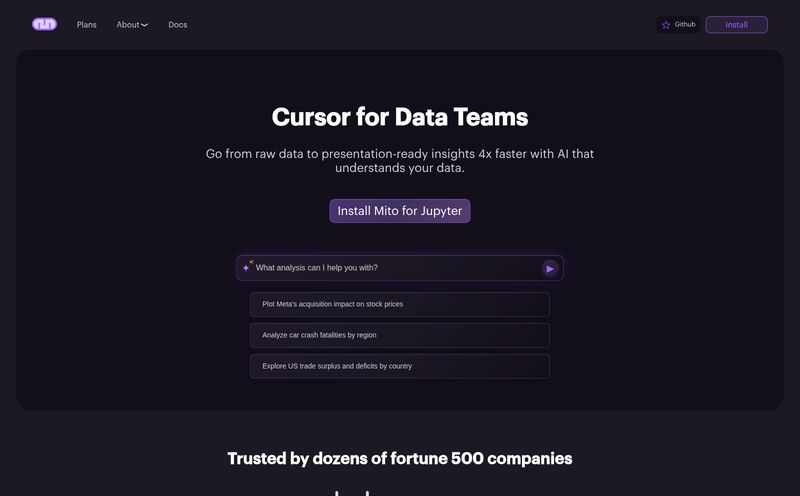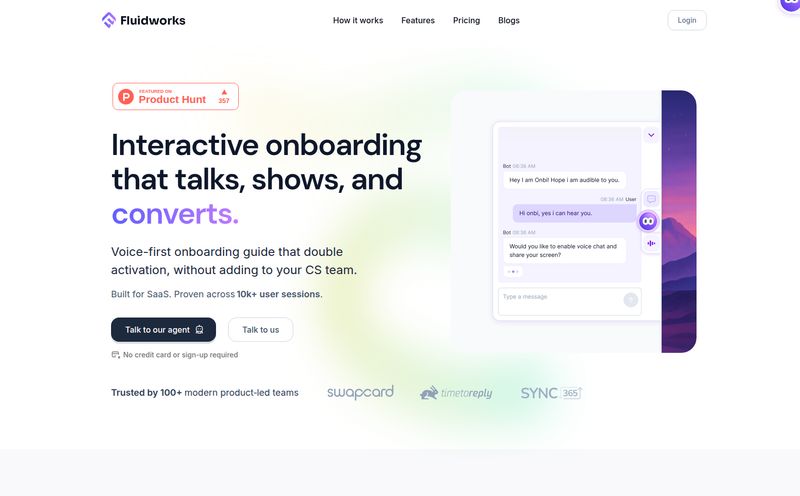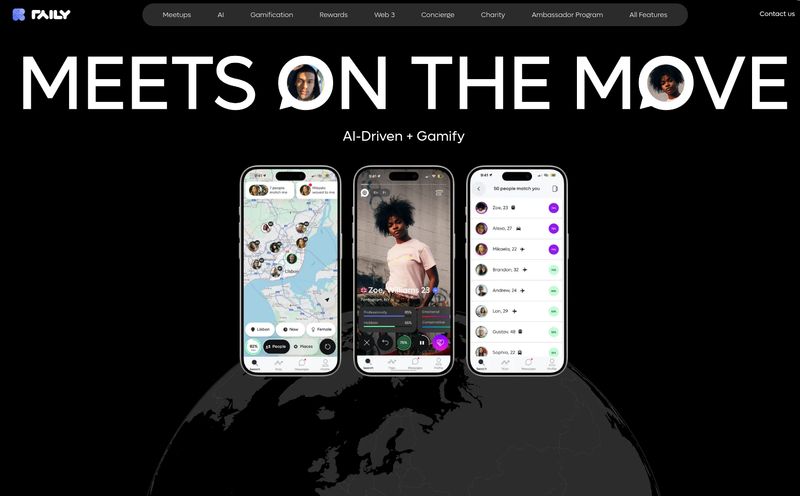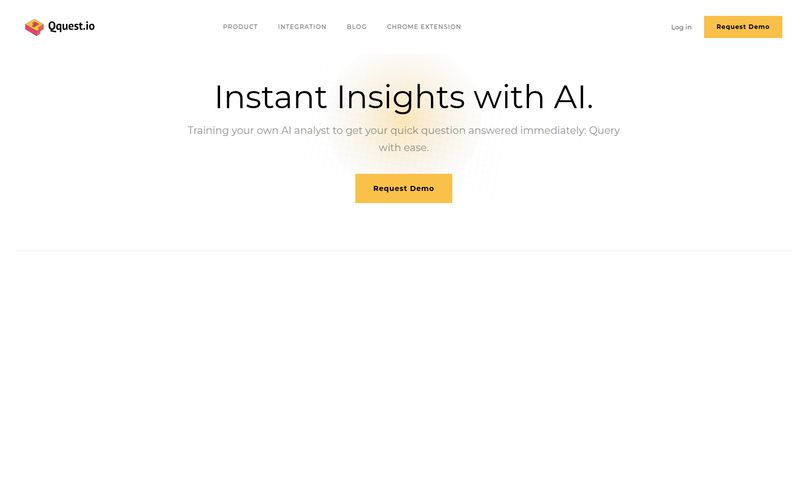PowerPoint. The mere mention of the name can send a shiver down the spine of even the most seasoned office worker. We've all been there—it's 10 PM, you're fueled by stale coffee, and you're nudging a text box one. single. pixel. at a time. You're convinced the alignment guides are lying to you. You spend more time wrangling shapes than you do thinking about the actual content. It’s a necessary evil, a tool so ingrained in corporate life that we just accept the pain.
But what if it didn't have to be that way? Every so often, a tool comes along that feels less like a piece of software and more like a sigh of relief. I've been hearing whispers about a new player in the AI productivity space called typeUp, a so-called “AI PowerPoint Copilot” that promises to make presentation building 10x faster. Ten times? That's a bold claim. As someone who has built more slide decks than I'd care to admit, my skepticism meter was tingling. But my curiosity got the better of me. So, I decided to take a look and see if typeUp is just another piece of vaporware or the secret weapon we've all been waiting for.
What is typeUp, Anyway?
In a nutshell, typeUp is a desktop application for Windows that acts as an add-in for PowerPoint. Think of it as a little AI-powered assistant that lives right inside the program you already use. Its main mission is to obliterate the most tedious, time-sucking parts of creating a presentation. We're talking about generating initial content, formatting slides, aligning objects, and digging for assets like images and icons. The big sell is that it uses AI to do the heavy lifting, freeing you up to focus on the message, not the mechanics. And maybe, just maybe, get some of your evening back.
It's not trying to reinvent the wheel or force you onto a whole new platform like Prezi or Canva. It meets you where you are—inside the familiar, sometimes frustrating, world of PowerPoint. That, to me, is a smart move.
My First Impressions and Getting Started
Getting it set up is straightforward—you download the app from their site, and it integrates with your existing PowerPoint desktop installation. The website itself is clean, dark-mode, no-nonsense. I appreciate that. It gets right to the point, showing off its features with simple animations. No fluff.
Once you're in, the tool is designed to be just a quick shortcut away. The website mentions a simple Ctrl + Tab to jump back and forth, which is a nice little workflow consideration. It shows they’ve thought about how people actually work, switching between research, notes, and the presentation itself. It’s those small details that often separate a good tool from a great one.
The whole thing feels slick and performance-optimized. One of their key points is that it runs locally on your machine. This is huge for two reasons: security and speed. No sending your potentially sensitive corporate data to a random cloud server, and no lag while you wait for a remote process to finish. It’s all right there. That alone earned it a few points in my book before I even got to the main features.
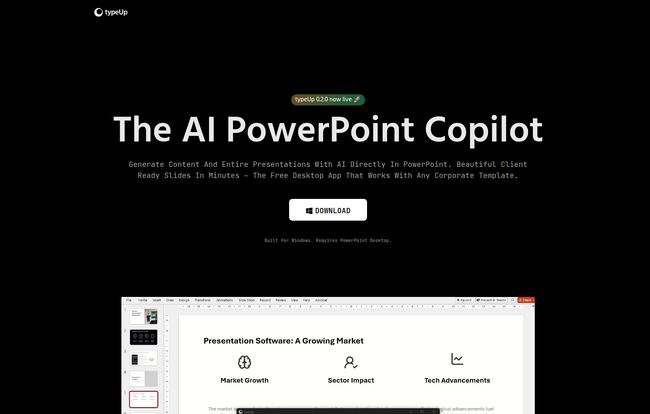
Visit typeUp
The Features That Actually Matter
Alright, let's get into the meat and potatoes. A tool can look pretty, but does it actually do the job? typeUp hangs its hat on a few core functions designed to be genuine time-savers.
The AI Slide Copilot
This is the headline act. The promise is that you can give the typeUp AI a simple prompt, and it will generate entire slides for you. We’ve seen this in tools like Tome and Microsoft's own Copilot, but having it integrated this way is interesting. The landing page mentions “Async AI agents, that write your slides.” This sounds pretty sophisticated—it suggests you can fire off a request for the AI to conduct research or build a deck, and it will work in the background without freezing up your whole computer. You're not just waiting and watching a loading bar. You can give it one or many tasks, maintaining control. For generating a first draft or getting past that dreaded ‘blank slide’ paralysis, this could be incredible.
Taming the Alignment Beast
If you've never wanted to throw your laptop out a window while trying to perfectly center five logos on a slide, you're a better person than I am. Wrangling objects in PowerPoint can feel like herding cats. Cats that are on fire. typeUp boasts single-click alignment functions. This might sound like a small thing, but I'd argue its one of the most impactful quality-of-life improvements imaginable for a frequent PowerPoint user. The cumulative time saved by not having to manually select, group, align, and distribute objects is probably measured in days over the course of a year. No exaggeration.
A Library at Your Fingertips
Sourcing assets is another huge time sink. You need a specific icon, a high-quality stock photo, or your partner's company logo. This usually means opening ten browser tabs, getting distracted by a new report from Search Engine Land, and forgetting what you were even looking for. typeUp puts a massive library right inside PowerPoint. We're talking over 200 slide layouts, a library of more than 30,000 icons, plus stock images. The real killer feature for corporate folks? A searchable logo library. Being able to just type “IBM” and drop their official logo perfectly onto your slide is a small, beautiful thing.
Working With Your Brand's Look
Here’s a feature that many other tools miss. typeUp claims to work with any corporate template. It can adapt its pre-built slide layouts to your company’s specific color scheme and fonts. This is a massive deal. Most businesses have strict branding guidelines, and tools that force you into their own aesthetic are a non-starter. By integrating with existing templates, typeUp avoids that problem entirely, making it instantly more useful in a professional setting.
The Good, The Bad, and The Pricey (or Not-So-Pricey)
No tool is perfect. So, let’s break down the reality of using typeUp.
On the plus side, the benefits are clear and compelling. The time savings are obvious, from the AI-powered content generation that gives you a running start to the alignment tools that polish the final product. The fact that it works with your existing corporate templates is a huge win, and the built-in libraries for images, icons, and logos streamline the whole creative process. But honestly, the biggest pro right now? It's free.
Of course, there are a few downsides. The most glaring one is that its a Windows-only application. Sorry, my fellow Mac users, we're left out in the cold on this one for now. You also need a full desktop installation of PowerPoint; it won't work with the web version. And while its features are powerful, they are, by design, limited to the PowerPoint ecosystem. If you're looking for a tool that also makes social media graphics and videos, you'll need to look elsewhere.
And what about the price? As I mentioned, the website currently states its free for individuals. There's no pricing page that I could find (the link seems to be broken, actually), which makes me think this might be an introductory offer to build a user base. This feels like one of those 'get in while it's free' situations. For what it offers, I wouldn't be surprised to see a subscription model introduced down the line, especially for teams or enterprise users.
Who is typeUp Really For?
So who should be downloading this right now? I see a few key groups.
- Consultants and Analysts: People who live and die by the slide deck. The speed and efficiency gains here would be monumental.
- Marketing and Sales Teams: Quickly creating customized, on-brand sales pitches and marketing presentations is the name of the game. typeUp seems custom-built for this.
- Students and Academics: Anyone who has to create presentations regularly for school or research will find the formatting and content generation tools incredibly helpful.
Who is it not for? If you only make one presentation a year, it's probably overkill. And if you're a die-hard Google Slides or Canva user who has left the Microsoft Office suite behind, this won't be the tool to pull you back in.
My Final Verdict on typeUp
After digging in, I have to say, I'm genuinely impressed. My initial skepticism has faded. typeUp isn't trying to be a magical, all-in-one solution that designs an award-winning deck for you while you sleep. Instead, it’s a practical, intelligently designed tool focused on a single goal: removing friction from the PowerPoint workflow. It automates the dumb stuff so you can focus on the smart stuff.
Will it make you 10x faster? You know, that's hard to quantify, but it doesn't feel like an outlandish claim for heavy users. The combination of AI drafting, one-click formatting, and integrated asset libraries will undoubtedly save hours of tedious work on any significant project. For my money, the alignment feature alone is worth the 'price' of admission (which is zero!).
If you're a Windows user who spends any significant amount of time in PowerPoint, you owe it to yourself to give typeUp a try. It’s a polished, powerful, and currently free tool that delivers on its core promise. What have you got to lose? Besides the late nights and alignment-induced rage, that is.
Frequently Asked Questions About typeUp
- Is typeUp really free?
- Yes, as of this writing, typeUp is listed as free for individual users on their website. This could change in the future, but for now, you can download and use it without cost.
- Does typeUp work on a Mac?
- Unfortunately, no. typeUp is currently only available for Windows and requires a desktop installation of Microsoft PowerPoint.
- Is my presentation data safe with typeUp?
- Yes. According to their site, typeUp runs locally on your computer. This means your data isn't uploaded to a third-party server, which is a major benefit for privacy and security, especially with sensitive corporate information.
- Can I use my own company's PowerPoint template with typeUp?
- Absolutely. One of typeUp's key features is its ability to work with any existing corporate template, adapting its layouts and styles to match your company's branding.
- How does the AI content generation work?
- You provide the AI with a prompt or topic, and its 'Async AI agents' generate text and structure for your slides. It's designed to be a starting point or a way to quickly build out sections of your presentation, which you can then edit and refine.
Conclusion
In a world full of AI tools making lofty promises, typeUp stands out by being practical. It doesn't try to dazzle with smoke and mirrors; it just makes a painful, everyday task significantly less painful. By focusing on the real-world bottlenecks of presentation design—alignment, asset sourcing, and initial drafting—it offers a clear and immediate value proposition. For the countless professionals stuck in the PowerPoint trenches, typeUp isn't just a tool; it's an exit strategy. An escape from the mundane and a ticket to more meaningful work.
References and Sources
- typeUp Official Website
- Search Engine Land (for industry context)
